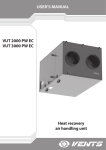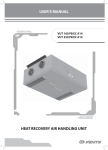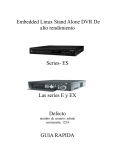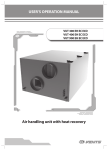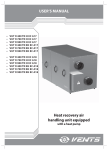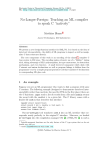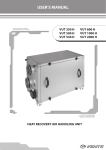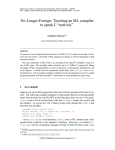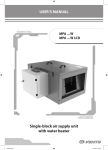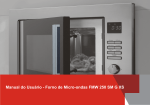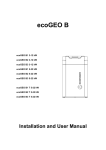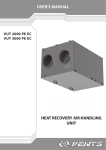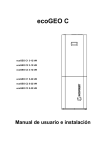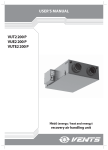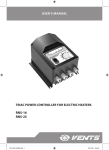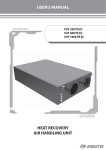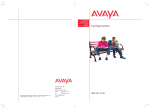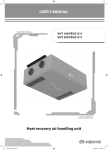Download User`s manual "VENTS VUT R WH EC" ( PDF 8,31Mb )
Transcript
USER’S MANUAL VUT R 400 WH EC A17 VUT R 700 WH EC A17 VUT R 900 WH EC A17 VUT R 1200 WH EC A17 VUT R 1500 WH EC A17 VUT R 2000 WH EC A17 VUT R 400 WH EC A18 VUT R 700 WH EC A18 VUT R 900 WH EC A18 VUT R 1200 WH EC A18 VUT R 1500 WH EC A18 VUT R 2000 WH EC A18 Heat recovery air handling unit equipped with a water heater V78EN-02.indd 1 21.08.2015 10:08:16 www.ventilation-system.com 2 CONTENTS Safety requirements Purpose Delivery set Designation key Technical data Unit design and operating logic Mounting and set-up Connection to power mains Unit control Technical maintenance Storage and transportation regulations Manufacturer's warranty Acceptance certificate Seller information Installation certificate Warranty card V78EN-02.indd 2 3 5 5 5 6 10 11 15 16 26 27 28 29 29 29 29 21.08.2015 10:08:16 3 This user’s manual consisting of the technical details, operating instructions and technical specification covers the installation and mounting of the VUT R WH EC heat recovery air handling unit (hereinafter referred to as «the unit»). SAFETY REQUIREMENTS • • • • • • Read the user’s manual carefully prior to installing and operating the unit. Fulfil the user’s manual requirements as well as the provisions of all the applicable local and national construction, electrical and technical norms and standards. The warnings contained in the user’s manual must be considered most seriously since they contain vital personal safety information. Failure to follow the rules and safety precautions noted in this user’s manual may result in an injury or unit damage. After a careful reading of the manual, keep it for the entire service life of the unit. While transferring the unit control the user’s manual must be turned over to the receiving operator. Symbol legend: WARNING! DO NOT! UNIT MOUNTING AND OPERATION SAFETY PRECAUTIONS V78EN-02.indd 3 • Disconnect the unit from power mains prior to any installation operations. • The unit must be grounded! • Do not lay the power cable of the unit in close proximity to heating equipment. • While installing the unit follow the safety regulations specific to the use of electric tools. • Do not change the power cable length at your own discretion. • Do not bend the power cable. • Avoid damaging the power cable. • Do not put any foreign objects on the power cable. • Unpack the unit with care. • Do not use damaged equipment or cables when connecting the unit to power mains. • Do not operate the unit outside the temperature range stated in the user’s manual. • Do not operate the unit in aggressive or explosive environments. • Do not touch the unit controls with wet hands. • Do not carry out the installation and maintenance operations with wet hands. • Do not wash the unit with water. • Protect the electric parts of the unit against ingress of water. 21.08.2015 10:08:19 www.ventilation-system.com 4 UNIT MOUNTING AND OPERATION SAFETY PRECAUTIONS V78EN-02.indd 4 • Do not allow children to operate the unit. • Disconnect the unit from power mains prior to any technical maintenance. • Do not store any explosive or highly flammable substances in close proximity to the unit. • When the unit generates unusual sounds, odour or emits smoke disconnect it from power supply and contact the Seller. • Do not open the unit during operation. • Do not direct the air flow produced by the unit towards open flame or ignition sources. • Do not block the air duct when the unit is switched on. • In case of continuous operation of the unit periodically check the security of mounting. • Do not sit on the unit and avoid placing foreign objects on it. • Use the unit only for its intended purpose. 21.08.2015 10:08:21 5 PURPOSE Due to the ability to save heating energy by means of energy recovery the unit is an important element of energy-efficient premises. The unit is a component part and is not designed for independent operation. The unit is designed to ensure continuous mechanical air exchange in houses, offices, hotels, cafés, conference halls and other utility and public spaces as well as to recover the heat energy contained in the air extracted from the premises to warm up the filtered stream of supply air. The unit is designed for floor and suspended mounting. The unit is rated for continuous operation. Transported air must not contain any flammable or explosive mixtures, evaporation of chemicals, sticky substances, fibrous materials, coarse dust, soot and oil particles or environments favourable for the formation of hazardous substances (toxic substances, dust, pathogenic germs). THE UNIT MAY NOT BE OPERATED BY CHILDREN OR PERSONS WITH REDUCED PHYSICAL, MENTAL OR SENSORY CAPACITIES, OR LACKING THE APPROPRIATE TRAINING. THE UNIT MUST BE INSTALLED AND CONNECTED ONLY BY PROPERLY QUALIFIED PERSONNEL AFTER THE APPROPRIATE BRIEFING. THE CHOICE OF UNIT INSTALLATION LOCATION MUST PREVENT UNAUTHORIZED ACCESS BY UNATTENDED CHILDREN. DELIVERY SET Name Number Air handling unit 1 item Control panel 1 item User's manual 1 item Packing box 1 item DESIGNATION KEY Unit type VUT - ventilation with heat recovery Heat exchanger type R - rotary Air capacity m3/h Heater type W - water heater Spigot orientation H - horizontal Motor type EC - electronically commutated motors Control A17 - th-Tune control panel with an LCD display A18 - pGD1 control panel with an LCD display V78EN-02.indd 5 VUT R XXX WH ЕС ХХХ 21.08.2015 10:08:21 www.ventilation-system.com 6 TECHNICAL DATA The unit is designed for indoor application with the ambient temperature ranging from +1 °C up to +40 °C and relative humidity up to 80 %. Hazardous parts access and water ingress protection rating: IP 44 for the unit motors IP 22 for the assembled unit connected to the air ducts The unit design is constantly being improved, so some models can slightly differ from those ones described in this manual. Voltage [V / Hz] VUT R 2000 WH EC VUT R 1500 WH EC VUT R 1200 WH EC VUT R 900 WH EC VUT R 700 WH EC VUT R 400 WH EC TECHNICAL DATA 1~ 220-240 / 50-60 Maximum fan power [W] 2 items x 100 2 items x 105 2 items x 135 2 items x 208 2 items x 222 2 items x 448 Total unit power [W] 290 315 440 570 750 1070 Total unit current [A] 1,2 1,4 1,9 2,5 3,2 5,0 Maximum air capacity [m3/h] 400 700 900 1200 1500 2000 up to 3100 up to 2600 up to 2600 up to 1930 up to 2000 up to 3000 45 52 58 60 62 64 r.p.m Sound pressure level at 3 m distance [dB(A)] Maximum transported air temperature [°C] -25…+60 Casing material aluzinc Insulation Filter: 25 mm mineral wool extract G4 intake G4 (F7*) Connected air duct diameter [mm] Weight [kg] Heat recovery efficiency [%] Heat exchanger type Heat exchanger material V78EN-02.indd 6 20 mm mineral wool Ø160 Ø250 Ø250 Ø315 Ø315 500x300 112 128 130 165 175 198 up to 85 rotary aluminium 21.08.2015 10:08:21 7 Р 400 ВГ ЕС | ВУТRР400/700/900 700 ВГ ЕС | ВУТ 900 ВГ ЕС OverallВУТ dimensions of VUT WHРEC E L1 F K1 K H G ØD N N1 J A A1 L OverallВУТ dimensions R 1200/1500 WH Р 1200 ВГof ЕСVUT | ВУТ Р 1500 ВГ ЕС | EC E F K1 K E H G N N1 J A A1 L Р 2000 ВГof ЕСVUT R 2000 WH EC OverallВУТ dimensions X F Y K1 K G H N N1 Unit model A J A1 L Dimensions [mm] øD A A1 E F G L L1 H J X Y K K1 N N1 VUT R 400 WH EC 159 1050 1167 225 167 333 648 200 670 440 - - 43 331 150 114 VUT R 700 WH EC 249 1210 1326 243 180 340 745 260 700 580 - - 43 365 150 130 VUT R 900 WH EC 249 1210 1326 243 180 340 745 260 700 580 - - 43 365 150 130 VUT R 1200 WH EC 314 1335 1450 373 220 438 745 - 880 460 - - 43 438 200 166 VUT R 1500 WH EC 314 1430 1535 427 275 460 855 - 1010 560 - - 43 504 250 172 VUT R 2000 WH EC - 1485 1754 - 275 480 875 - 1010 630 500 300 43 540 250 172 V78EN-02.indd 7 21.08.2015 10:08:22 www.ventilation-system.com 8 Calculation of water heater parameters for VUT R 400/700/900 WH EC Air temperature downstream of the heater [°C] Outside air temperature [°C] Heating coil capacity [kW] Water pressure drop [kPa] Air speed inside the heater [m/s] Air flow through the heating coil [m3/h] Water flow through the water heating coils [l/s] Water heater parameters calculation example: Air Speed. Starting from 650 m3/h on the air flow scale draw a vertical line (1) till the air speed axis which makes 2.35 m/s. Supply air temperature: prolong the line [1] up to the point where it crosses the outside air temperature (blue curve, e.g. +5 °C); then draw a horizontal line [2] from this point to the left until it crosses the water in/out temperature curve (e.g. 70/50). From this point draw a vertical line [3] to the supply air temperature axis on top of the graphic (+26 °C). Heating coil capacity: prolong the line [1] up to the point where it crosses the outside air temperature (e.g. +5 °C, red curve) and draw a horizontal line [4] from this point to the right until it crosses the water in/ out temperature curve (e.g. 70/50). From here draw a vertical line [5] up to the scale representing the heating coil capacity (5.8 kW). Water flow: Prolong the line [5] down to the water flow axis [6] at the bottom of the graphic (0.04 l/s). Water pressure drop. Draw the line (7) from the point where line (6) crosses the black curve to the pressure drop axis (0.5 kPa). Calculation of water heater parameters for VUT R 1200 WH EC Air temperature downstream of the heater [°C] Air speed inside the heater [m/s] Air flow through the heating coil [m3/h] Water pressure drop [kPa] Outside air temperature [°C] Heating coil capacity [kW] Water heater parameters calculation example: Water flow through the water heating coils [l/s] Air Speed. Starting from 1000 m3/h on the air flow scale draw a vertical line (1) till the air speed axis which makes 2.22 m/s. Supply air temperature: prolong the line [1] up to the point where it crosses the outside air temperature (blue curve, e.g. +5 °C); then draw a horizontal line [2] from this point to the left until it crosses the water in/out temperature curve (e.g. 70/50). From this point draw a vertical line [3] to the supply air temperature axis on top of the graphic (+28 °C). Heating coil capacity: prolong the line [1] up to the point where it crosses the outside air temperature (e.g. +5 °C, red curve) and draw a horizontal line [4] from this point to the right until it crosses the water in/ out temperature curve (e.g. 70/50). From here draw a vertical line [5] up to the scale representing the heating coil capacity (9.0 kW). Water flow: prolong the line [5] down to the water flow axis [6] at the bottom of the graphic (0.11 l/s). Water pressure drop. Draw the line (7) from the point where line (6) crosses the black curve to the pressure drop axis (0.8 kPa). V78EN-02.indd 8 21.08.2015 10:08:22 9 Calculation of water heater parameters for VUT R 1500/2000 WH EC Air temperature downstream of the heater [°C] Air speed inside the heater [m/s] Air flow through the heating coil [m3/h] Water pressure drop [kPa] Outside air temperature [°C] Heating coil capacity [kW] Water flow through the water heating coils [l/s] Water heater parameters calculation example: Air Speed. Starting from 1200 m3/h on the air flow scale draw a vertical line (1) till the air speed axis which makes 2.25 m/s. Supply air temperature: prolong the line [1] up to the point where it crosses the outside air temperature (blue curve, e.g. +5 °C); then draw a horizontal line [2] from this point to the left until it crosses the water in/out temperature curve (e.g. 70/50). From this point draw a vertical line [3] to the supply air temperature axis on top of the graphic (+27 °C). Heating coil capacity: prolong the line [1] up to the point where it crosses the outside air temperature (e.g. +5 °C, red curve) and draw a horizontal line [4] from this point to the right until it crosses the water in/ out temperature curve (e.g. 70/50). From here draw a vertical line [5] up to the scale representing the heating coil capacity (11.0 kW). Water flow: prolong the line [5] down to the water flow axis [6] at the bottom of the graphic (0.13 l/s). Water pressure drop. Draw the line (7) from the point where line (6) crosses the black curve to the pressure drop axis (0.8 kPa).. V78EN-02.indd 9 21.08.2015 10:08:23 www.ventilation-system.com 10 UNIT DESIGN AND OPERATING LOGIC The unit has the following operating logic: Warm stale extract air from the room flows to the unit, where it is filtered by the extract filter. Then the air is moved through the rotary heat exchanger and is exhausted outside with the exhaust fan. Clean cold air from outside is moved to the intake filter. Then filtered air flows through the rotary heat exchanger and the water heater where it is warmed up to the pre-set temperature value and is moved to the room with the supply fan. Heat energy of warm extract air is transferred to clean intake fresh air from outside and warms it up in the rotary heat exchanger. Heat recovery minimizes thermal energy losses and space heating expenses in cold seasons. Unit operation logic (service side view) Exhaust fan Rotary heat exchanger Extract filter Control unit EXHAUST AIR EXTRACT AIR INTAKE AIR SUPPLY AIR Supply fan Water heater Intake filter The unit is a framework construction that includes a frame made of rigidly fixed sandwich panels. The three-layer sandwich panels are made of aluminium and galvanized sheets, internally filled with a heat- and sound-insulated layer of mineral wool. The air handling unit is equipped with quick-detachable service panels for scheduled repair and maintenance operations. Route power and ground cables through the screwed cable glands to connect those to the terminal block located in the control unit. The wiring diagram is shown on the inner side of the control unit cover. V78EN-02.indd 10 21.08.2015 10:08:23 11 MOUNTING AND SET-UP While mounting the unit provide enough access for maintenance or repair work. The minimum recommended clearances between the unit and the adjoining walls are given in the figure below. Before starting the unit make sure that the rotary heat exchanger cells are clean and free from damage. Check the belt tension. The tension force is regulated by the spring on the motor suspension mount. The unit may be suspended on a threaded rod that is fixed inside a dowel or may be rigidly fixed on a horizontal plane. SERVICE ACCESS Model 60 mm VUT R 400 WH EC A, mm VUT R 700 WH EC VUT R 900 WH EC K 800 mm 900 mm G 3/4’’ VUT R 1200 WH EC VUT R 1500 WH EC VUT R 2000 WH EC А B 1000 mm G 1’’ B - provide enough distance for connection of a water heater. K SUSPENDED MOUNTING UNIT MOUNTING ON A HORIZONTAL PLANE To attain the optimal performance of the unit and to minimise turbulence-induced air pressure losses connect a straight air duct section on both sides of the unit while mounting. Minimum straight air duct length: • equal to 1 air duct diameter on intake side; • equal to 3 air duct diameters on outlet side. If the air ducts are not connected or the connected air ducts are too short, protect the unit parts from ingress of foreign objects by covering the spigots with a protecting grille or other protecting device with mesh width not more than 12.5 mm to protect internal parts of the unit against penetration of foreign objects. SAFETY PRECAUTIONS The unit must be mounted to a rigid and stable structure. The unit must be suspended using anchor bolts. Make sure that the base structure is capable of sustaining the unit weight. Otherwise reinforce the mounting location with beams or similar elements. If the bolts used for the unit mounting are too short the unit can generate abnormal noise and resonate with the ceiling. Use bolts of sufficient length to prevent resonance. Threaded rod If the abnormal noise is generated at the spiral air duct joint replace the spiral air duct Nut with a flexible one to prevent resonance. Flexible anti-vibration connectors are another Vibration absorbing rubber alternative for dealing with resonance. UNIT MOUNTING Washer Install M8 anchor bolts before proceeding with the installation. Insert the anchor Nut and lock nut bolt into the suspended mounting opening and secure it with nuts and washers. The unit mounting example is shown in the illustration on the right. L-shaped bracket V78EN-02.indd 11 21.08.2015 10:08:24 www.ventilation-system.com 12 WATER HEATER CONNECTION Use a pipe spanner for connection of a water heater. Do not apply excessive force while tightening the water works fittings when connecting a water heater. A pipeline system connected to a water heater is designed for normal operation in premises with air temperatures above 0 °C! If the temperature is expected to drop below 0°C it is necessary to provide appropriate thermal insulation or air heating at the site of unit operation. In order to achieve maximum power the water heater should be counterflow connected (see the figure below). To connect the water heater on direct-flow basis relocate the return heat medium temperature sensor to the downstream side of the water heater. All the stated calculations and diagrams are valid for counterflow connection of the water heater. In case of direct-flow connection the water heater has lower power but higher frost-resistant properties. Counterflow connection Direct-flow connection Water outlet Water inlet Water inlet Water outlet MIXING UNIT DIAGRAM 1. 5. 2. 3. 4. 7. 2. 6. 9. 8. 1. Water heater 2. Shutoff valves. 3. Circulation pump. 4. Bypass damper. 5. Boiler. 6. Heat medium regulating valve with an electric actuator. 7. Non-return valve. 8. Coarse filter. 9. Water pressure sensor (nc). HEAT MEDIUM REGULATING VALVE ACTUATOR V78EN-02.indd 12 21.08.2015 10:08:25 13 TH-TUNE CONTROL PANEL INSTALLATION To install the rear part of the control panel use a suitable mounting box (minimum diameter 65 mm and minimum depth 31 mm). 1. Use a screwdriver to pull the front and the rear sides of the control 2. Disconnect the 4-pin socket from the front part of the control panel. panel apart. 3. Complete the electrical connections according to the external wiring diagram (Page 15). 4. Secure the rear part of the control panel in the mounting box using the screws supplied. 5. Reattach the 4-pin connector. 6. Lay all the cables and install the control panel starting from the bottom. Make sure that none of the internal wires prevent closing with a click. 5 5 4 6 6 4 74 60 Overall dimensions of the control panel rear part, mm 60 74 V78EN-02.indd 13 21.08.2015 10:08:26 www.ventilation-system.com 14 PGD1 CONTROL PANEL INSTALLATION Connect the pGD1 control panel to the controller connector (see figure on page 13) using the 6P6C (PLUG-6P6C-P-C2) phone plug. The maximum length of the phone cable is 50 m. To mount the control panel on a wall route the phone cable to the selected location. 1. Secure the rear part of the casing in the standard box by means of the round-head screws supplied. 2. Connect the phone cable to the front part of the control panel. Install the frond part of the control panel into the box by fastening it to the rear part of the casing with countersunk screws supplied as shown in the figure below and then install the front bezel by pushing it until it clicks in position. V78EN-02.indd 14 21.08.2015 10:08:27 15 CONNECTION TO POWER MAINS DISCONNECT THE UNIT FROM POWER SUPPLY PRIOR TO ANY OPERATIONS WITH THE UNIT. CONNECTION OF THE UNIT TO POWER MAINS IS ALLOWED BY A QUALIFIED ELECTRICIAN WITH A WORK PERMIT FOR THE ELECTRIC UNITS UP TO 1000 V AFTER CAREFUL READING OF THE PRESENT USER’S MANUAL. THE RATED ELECTRICAL PARAMETERS OF THE UNIT ARE GIVEN ON THE MANUFACTURER’S LABEL. ANY TAMPERING WITH THE INTERNAL CONNECTIONS IS PROHIBITED AND WILL VOID THE WARRANTY. The air-handling unit is rated for connection to single-phase AC 230 V / 50/60 Hz power mains. The connection must be made using durable, insulated and heat-resistant cables with a minimum cross-section of 1.5 mm2 (up to 50 m long). The cable cross-section is given for reference only. The actual conductor cross-section selection must be based on its type, the maximum permissible heating, insulation, length and installation method. Use copper cables only. Connect the unit to power mains on the terminal block which is located in the control unit in compliance with the wiring diagram and the terminal marking. Connect the unit to power mains through the external automatic circuit breaker with a magnetic trip integrated into the fixed wiring system. The trip current of the automatic circuit breaker must correspond to the current consumption (see the table on page 6). VUT R 400-2000 WH EC wiring diagram X1 X2 1 2 3 4 5 6 7 8 9 10 11 12 13 14 15 16 17 18 19 1 2 3 N Y G GO PE N L1 PE N 2 1 2 1 2 1 1 L Y N SM1* PK1* 2 1 L N SM2* PE N L ~ SM3* M3* Power input 230 VAC Cooler enable signal (no-contact, 16 A) th-Tune 24V~ GND~ grey L white 1 L Name Model Wire** max 0.3 kW 3x0,75 mm2 Supply air damper electric actuator LF230 2x0,75 mm2 SM2* Exhaust air damper electric actuator LF230 2x0,75 mm2 SM3* Heat medium regulating valve actuator LR24-SR 3x0,75 mm2 PK1* Contact from fire alarm panel NC 2x0,75 mm2 M3* Circulation pump SM1* P1 Preheating enable signal (no-contact, 15 A) P1 G G0 NO NO NO NO 2 Rx-/Tx- yellow brown Rx+/Tx+ GND green gnd R+ R- Design. Control panel th-Tune * - Devices are not included into delivery set, but can be delivered according to the order. ** - Wire cross-section at a cable length of maximum 100 m. Maximum cable length from controller to control panel Cable type Distance to power source Phone cable up to 50 m AWG24 shielded cable up to 200 m — Electric shock hazard! V78EN-02.indd 15 21.08.2015 10:08:28 www.ventilation-system.com 16 UNIT CONTROL The unit is equipped with a built-in automatic control system and a control panel. Control unit of VUT R 400-2000 WH EC pGD1 control panel connector Transformer 230 VAC / 24 VAC Electromagnetic relay Bolt-down terminal Ground terminal Controller The automatic control system has the following functions: 1. Turning the unit on/off 2. Unit operation mode selection: Automatic mode, Ventilation mode (can be enabled only from the pGD1 control panel). 3. Maintaining a pre-set room temperature by activating/ deactivating the rotary heat exchanger as well as setting a required water heater heating capacity and its smooth controlling. 4. Automatic reduction of the supply and exhaust ventilation flow rate to obtain the user-defined heating temperature. 5. Supply and exhaust fan control. 6. Unit operation according to a pre-programmed schedule. 7. Controlling the electric actuators of the supply and exhaust air dampers. 8. System shutdown on signal from fire fighting system. 9. When connecting external electrical heating elements and/or CCU to the unit the activation signal controls their operation if cooling/heating is required. 10.Filter contamination control by the number of operating hours. 11.Water heater freeze protection in the winter period. Terminal block AUTOMATIC CONTROL SYSTEM DESIGN AND OPERATION The automatic control system comprises a Carel controller (PCO5 compakt), an outdoor air temperature sensor, a supply air temperature sensor, a sensor for the air temperature in the exhaust duct, a room temperature sensor, relays, a return heat medium temperature sensor, circuit breakers, a supply transformer and a water heater overheat protection thermostat. The unit is controlled via th-Tune or PGD1 control panel. The automatic control system enables safe automatic operation of the unit in the Auto or Ventilation mode. The Ventilation mode can be enabled only from the pGD1 control panel. In the Auto mode the unit maintains the indoor temperature at the pre-set level by sending a signal to the actuators of the water heater damper and the rotary heat exchanger. While in the Ventilation mode the unit adjusts the supply and exhaust fan speed. The Ventilation mode is appropriate for energy saving if the difference between the outdoor and indoor temperatures is insignificant. The supply and exhaust fan speed is set for each speed stage as a percentage from the maximum rotation speed. The temperature is set up by changing the “Setpoint” parameter value. The fans can be operated according to a daily schedule (up to 4 time ranges). The Automatic Speed Drop mode is enabled when the air temperature is low. In this mode the fan speed is adjusted according to the supply air temperature. The speed is reduced at temperature dropping and is restored to the initial setting provided a sufficient temperature reserve. The unit switches between Heating and Cooling modes according to the outdoor temperature (factory setting +18 °C). The unit incorporates a number of protective measures against water heater freezing: If the temperature drops below +14 °C (factory setting) in the Heating mode and +8 °C in the Cooling mode the unit turns off. If the outdoor air temperature drops below +10 °C the “Winter start” mode is activated. When activating the unit the water heater is warmed up first: the heat medium pump switches on, the heat medium regulating valve is opened to the maximum to warm up before starting the fans. When the return heat medium temperature reaches +55 °C the air dampers are opened and the fans are switched on. In winter the controller maintains a return heat medium temperature of not less than +25 °C for preventing a water heater failure. To prevent a water heater freezing in the Heating mode the Water Heater Warm-Up mode is activated when the heat medium temperature drops below +10 °C. The automatic control system generates an alarm signal to warn of low heat medium temperature. The warning alarm is switched off automatically when the heat medium temperature exceeds +55 °C. A freeze protection thermostat of a water heater is active in any mode. WARNING! Changing the thermostat settings will void the Warranty. In case of a freezing danger the fans are turned off, the supply air damper is closed, the heat medium regulating valve is fully opened to provide 100 % air capacity of a heat medium and the circulating pump is switched on. V78EN-02.indd 16 21.08.2015 10:08:29 17 UNIT CONTROL PANELS The unit is controlled via the th-Tune or pGD1 control panel. Button Functions Operation mode selection: set the operation mode according to the procedure described on page 20. Fan speed selection: set the desired speed level (Low, High or Medium). While the Automatic Speed Drop mode is enabled the fan speed is set automatically to maintain the supply air temperature above the threshold level. Time range on/off: short pressing. Activation is confirmed by a pictogram . Access to the clock/time range setup menu: press and hold for 3 seconds. Use the rotary knob to choose the necessary option: setting the current date/time: starts blinking. Turn the knob to make the desired setting and press to confirm. TIMEBAND: setting the time range. Press to set the start time and the corresponding temperature setpoint for each time range individually (you may create up to six time ranges). The pictograms show the current time of a day status (i.e. Day/ Nigh) and the presence or absence of inhabitants in the serviced spaces. Press ESC to exit and return to the standard display mode. ESC: exit. After 10 seconds th-Tune returns to the main menu automatically. th-Tune Unit activation/deactivation; in some menus a short pressing has the same function as ESC. PUSH 1 3 Display pictograms: 4 5 6 2 7 8 19 9 18 10 11 V78EN-02.indd 17 12 13 14 15 16 Enter the desired value and press to confirm. 17 1. 2. 3. 4. 5. 6. 7. 8. 9. 10. 11. 12. 13. 14. Operation mode. Main field. Fan mode: Manual/Auto. Fan speed indicator. Temperature measurement unit. Lock function. Setpoint value. Disabled. Current time range. Day of the week. "Alarm" signal. Circulation pump operation signal. Cooler operation enable signal. Disabled. 15. Fan operation signal. 16. 17. 18. 19. External electric heating elements operation enable signal. Disabled. Auxiliary field. Unit scheduled operation enabled. 21.08.2015 10:08:31 www.ventilation-system.com 18 Connect the pGD1 control panel to the controller connector (see figure on page 13) using the 6P6C (PLUG-6P6CP-C2) phone plug. The maximum length of the phone cable is 50 m. The pGD1 offers extended functionality and has identical settings entered via the controller screen (see “Controller functions and menu”). pGD1 The main page of the control panel menu displays the following information: • date and current time; • indoor temperature (the temperature registered by sensors can be browsed by pressing the “Up” and “Down” buttons: outdoor and supply air temperature, the temperature downstream of the heat exchanger and in the exhaust air duct); • unit operation mode; • set-point temperature; • selected speed; • scheduled operation status (on/off ); The main page enables access to the user or engineering menu containing extended information specific to the unit operation and detailed parameters for adjustment. PLAN NETWORK CONFIGURATION WHILE USING AN EXTERNAL CONTROL PANEL (pGD1). To enable interaction with the control panel boot up the controller in the pLan mode and assign the following pLan addresses to the controller and the control panel: Controller – 1; Control panel (pGD1) – 30, 31 or 32 (factory default value). SETTING PLAN ADDRESS FOR THE CONTROL PANEL (pGD1). 1. Connect the control panel to the controller and power up the controller. 2. Ignore any information which might show on the display screen and simultaneously press the “Up”, “Down” and “Enter” buttons and hold them for 3-5 seconds. After this time the message “Display address setting…..32” appears on the display screen. 3. Move the cursor to the address setting field using the “Enter” button. Use the “Up” and “Down” buttons to set the desired address value and press “Enter”. SETTING CONTROLLER PLAN ADDRESS VIA THE BUILT-IN CONTROL PANEL. 1. Power off the controller. 2. Power up the controller and immediately press the “Up” and “Alarm” buttons simultaneously. Hold the buttons pressed until the controller page appears on the screen (wait for about 15 seconds): 3. Use the “Up” and “Down” buttons to set the device address to 1. 4. Press the “Enter” button within 10 seconds to confirm. Failure to press the button within 10 seconds will cause the controller to close the address setting page automatically while keeping the original address value. 5. Upon confirmation the controller will restart with a new pLan address automatically. SETTING CONTROLLER PLAN ADDRESS VIA pGD1 CONTROL PANEL. To set the controller address use the pGD1 panel to set the control panel (dGD1) address to 0. To do this follow the steps described in “SETTING PLAN ADDRESS FOR THE CONTROL PANEL (pGD1)” paragraph above. Upon setting the control panel address to zero by using the respective buttons on the external control panel follow the steps described in “SETTING CONTROLLER PLAN ADDRESS VIA THE BUILT-IN CONTROL PANEL” paragraph. After setting the controller address set the pLan address of the control panel (pGD1) to 30, 31 or 32. V78EN-02.indd 18 21.08.2015 10:08:32 19 CONTROLLER FUNCTIONS AND MENU The controller has the following controls and indicators: Backlit LCD display. The display screen shows the current parameters of the system operation, temperature values, pre-set parameters and alarms. Control buttons of the automatic control system: Enter Enters specific modes: editing a parameter, saving an edited parameter and function list navigation Down Navigating one level down or decreasing the edited parameter value Up Navigating one level up or increasing the edited parameter value Cancel Cancelling the parameter edits and exiting the submenu Parameters Access to the additional parameters menu Alarms Access to the alarms view and reset menu THE SERVICE SETTINGS ARE PROGRAMMED AT THE FACTORY. THESE SETTINGS MAY BE CHANGED ONLY BY QUALIFIED SPECIALISTS UPON ENTERING THE SERVICE PASSWORD. CHANGING OTHER PARAMETERS DOES NOT REQUIRE A SERVICE PASSWORD. UNIT START 1. Upon starting the unit choose the controller interface language by using the and buttons and then press . 2. Once the interface language has been selected, the controller firmware will load. MAIN MENU Current date Current time Current temperatures Room temperature Downstream of the heat exchanger Outside temperature Supply air Unit operation mode OFF FANS Heating Cooling Auto Scheduler The temperature value for the selected mode Fan speed level Low Medium High V78EN-02.indd 19 21.08.2015 10:08:33 www.ventilation-system.com 20 To modify the unit operation parameters move the cursor to the required line using the the desired value and then press the button. Then use the and buttons to set to confirm. To exit the parameter change mode without saving the changes press the button. VIEWING THE READINGS FROM THE TEMPERATURE SENSORS To view the readings from the temperature sensors installed in the unit move the cursor to the upper left corner by means of the button and then use the and buttons to select the necessary sensor for viewing. 1. Room temperature. The feedback is provided by the temperature sensor built into the control panel or the exhaust duct temperature sensor. 2. Supply air temperature. The feedback is provided by the temperature sensor built into the supply duct downstream of the heat exchanger and the water heater. 3. Outside air temperature. The feedback is provided by the temperature sensor built into the supply duct upstream of the heat exchanger. UNIT OPERATION MODE SELECTION The unit has 4 operation modes. To select the desired mode set the cursor at the “Mode” word by using the and buttons to set the desired value and then press the to confirm. 1. OFF — the fans and the heat exchanger are disabled. Temperature and speed settings are not available. 3. Auto mode — the fans, the heat exchanger and the water heater are enabled. The user may change the temperature and speed settings. While in this mode the unit automatically adjusts the water heater operation to attain the pre-set temperature at the selected speed. V78EN-02.indd 20 button. Then use the 2. FAN — the fans run at the pre-selected speed. The heat exchanger and the water heater are disabled. The temperature settings are not available. This mode can be enabled only from the pGD1 control panel. 4. Scheduler — the fans, the heat exchanger and the water heater are enabled. Temperature and speed settings are not available. While in this mode the unit operates according to a pre-programmed schedule. 21.08.2015 10:08:34 21 TEMPERATURE SETTING To modify the temperature setting set the cursor at “Setpoint” by using the button. Then use the and buttons to set the desired temperature value and then press the to confirm. Temperature setting range: from +15 °C up to +30 °C. FAN SPEED SETTING To select the desired fan speed set the cursor at “Fan speed” by using the button. Then use the and buttons to set the desired value and then press the to confirm. Three fan speed stages are available: Low, Medium, High. The fan rotation speed corresponding to each speed stage is set as a percentage of the maximum capacity of each fan via the unit parameter setup menu. UNIT PARAMETERS To enter the user parameter menu press the button to enter. button. Use the and buttons to select the desired menu item and press the 1. System information To view the system information enter the user parameter menu and select “System info”. The “System info” menu consists of three pages. To navigate between the pages use the and buttons. Page 1/3 contains the following parameters: • Current supply fan speed [%] • Current exhaust fan speed [%] • The current state of the heat exchanger: On - heat exchanger enabled Off - heat exchanger disabled • Current level of opening of the heat medium regulating valve [%]. • Current status of preheating enable signal: On - preheating allowed Off - preheating denied • Current status of the cooler enable signal: On - cooler operation allowed Off - cooler operation denied On - the pump is turned on Off - the pump is turned off V78EN-02.indd 21 21.08.2015 10:08:35 www.ventilation-system.com 22 Page 2/3 contains the following parameters: • Outside air temperature [°C] • Supply air temperature [°C] • Exhaust duct temperature [°C] • Exhaust duct temperature [°C]. When selecting “Main sensor: Exh. Air” in the “Parameter” field. • Room temperature [°C]. When selecting “Main sensor: in thTune” in the “Parameter” field. Page 3/3 contains the controller firmware information. 2. Set time & scheduler To set the clock and operation schedule enter the user parameters menu and select “Set time & scheduler”. The “Set time & scheduler” menu consists of four pages. To navigate between the pages use the and buttons. WARNING! With the th-Tune control panel connected the operation schedule is set via the control panel! Page 1/4 enables setting the unit operation schedule. Press the button to select the desired parameter and then set its value using the and buttons. Schedule setup. This mode can be enabled only from the pGD1 control panel. When using th-Tune the schedule is set up according to the th-Tune control panel description. 1. Day selection. Use the and 2. Setting the schedule recording start time. button to select the “Day” parameter and then use the Press the buttons to select the day for setting the schedule. and button to start setting the first entry. Then use the buttons to set the start time for the first entry in hours. After that press the use the 3. Operation mode setup. V78EN-02.indd 22 and • • buttons to set the minute value. 4. Selecting a setpoint. After setting the time press the mode. Use the modes: • OFF • FANS and button to set the time in minutes and then button to set the unit operation buttons to select one of the following Auto Scheduler After setting the operation mode press the button to adjust the setpoint. Use the and buttons to select one of the preprogrammed setpoints. Open the “Set time & scheduler” menu on page 3/3 to define the setpoints on page 4/4. 21.08.2015 10:08:35 23 5. Setting up other entries. Other entries are set up similarly. 6. Copying schedule entries to other days. After programming all the necessary entries they can be copied to any other day of the week as follows: 1. Use the button to set the cursor at “Copy to”. 2. Use the days. 3. Press and buttons to select a day of the week or all and then use the and buttons to select “Yes”. 4. To confirm the copying operation press the button. Setting up exception periods Page 2/4 While in the Scheduled operation mode you may need to create a period of operation to a different set of scheduled settings between two identical entries. This is done by setting exception periods. Exception period setting. To select a parameter press the Then use the and button. buttons to set the desired parameter value. Setting up special days Page 3/4 While in the Scheduler you may need to program a special set of parameters for a whole day. This is done by setting up special days. 1. Setting up the special day date. 2. Setting up the special day month. 3. Setting up the special day mode. Press the the and day to. V78EN-02.indd 23 Select the “Date” parameter by pressing the the and a special day. buttons to select the day in the month to designate button to select the “Month” parameter and then use Select the “Mode” parameter by pressing the buttons to select the month for assigning a special use the and special day. button and then use button and then buttons to assign the operation mode to the 21.08.2015 10:08:36 www.ventilation-system.com 24 4. Selecting the special day setpoint. Press the and button to select the “Set.” parameter and then use the 5. Setting up other special days. Other special days are set up similarly. buttons to select the setpoint required on the special day. Once done with the special day setup press the the changes. After pressing the button to save button the cursor will jump to the first step of setting the next special day. Setting up setpoints Page 4/4 The setpoints for schedule entries are programmed on page 4/4. Setting up setpoints. Press the button to select a parameter. Then use the and buttons to set the desired parameter value. You may program up to three entries. Set the fan speed and temperature for each setpoint. UNIT PARAMETER SETUP To set up the unit parameters enter the user parameters menu and select “Parameters”. The “Parameters” menu consists of four pages. To navigate between the pages use the and buttons. Page 1/04 Fan speed setting. Use the button to select the supply or exhaust fan speed as necessary and then press the and buttons to set the speed value as a percentage of the maximum speed. After that press the button to save the settings. The “Main sensor” parameter allows changing the temperature measuring location to account for the value and subsequent processing by the firmware. If the unit serves a number of spaces the parameter value should be set to “Exh. air” When setting or editing a parameter the th-Tune” control panel must be installed in the space supplied by the unit. V78EN-02.indd 24 21.08.2015 10:08:37 25 Page 2/04. Setting up temperature setpoints. T1 is the setpoint for the supply air temperature at which the unit will switch to a lower speed in case of failure to attain the pre-proPress the button to select the temperature setpoint and then use grammed temperature conditions. the and buttons to define the temperature setpoint value. T4 is the temperature increase relative to T1 for switching to the pre-programmed speed. After that press the button to save the settings. Page 3/04. Temperature regulator operation setup. For “Winter” and “Summer” modes it is possible to choose the type of the temperature regulator. If the temperature regulator type value is “0” the temperature is controlled by supply air temperature. If the temperature regulator type value is “1” the temperature is controlled by room temperature Page 4/04. Hour meter operation. On elapsing of the filter replacement interval (3,000 hours by default) the system will generate a filter replacement alert. To reset the filter replacement alerts once the filter has been replaced press the button to make the following menu selection: • Hour meter reset — “RESET”. • To change the filter replacement alert parameter set the time as desired and press . ALARMS In the event of an alarm the controller display shows the gram. picto- The controller resets the alarm automatically on detecting that its cause has been eliminated. To respond to an alarm press the button to enter the active alarms menu. List of possible alarms is show in the “Technical data” section (p. 27). The active alarms can be reset manually. To reset an alarm manually press the button while in the active alarms menu to enter the alarm management menu. The alarm management menu enables the following actions: — viewing the current alarm list; — viewing the alarm history; — reset the alarms. V78EN-02.indd 25 21.08.2015 10:08:37 www.ventilation-system.com 26 TECHNICAL MAINTENANCE DISCONNECT THE UNIT FROM POWER MAINS PRIOR TO ANY MAINTENANCE OPERATIONS. Maintenance operations of the unit are required 3-4 times per year. Maintenance includes general cleaning of the unit and the following operations: 1. Filter maintenance: Dirty filters increase air resistance in the system and reduce supply air volume. The filters require cleaning not less than 3-4 times per year. On elapsing of 3,000 operating hours the unit controller generates the filter replacement or cleaning alert. Clean or replace the filters and reset the hour meter. Vacuum cleaning is allowed. After two consecutive cleanings filters must be replaced. For new filters contact the Seller. Sequence of filter removal: 1. Disconnect the unit from power mains. 2. Undo the screws securing the service panels in place. 3. Remove the side panels. 4. Pull the filters to remove. 5. Replace the filters in the reverse order. SEQUENCE OF FILTER REMOVAL 1. 2. 3. 2. Heat exchanger maintenance (once per year). Some dust may accumulate on the heat exchanger block even in case of regular maintenance of the filters. To maintain the high heat recovery efficiency, regular cleaning is required. To clean the heat exchanger remove it from the unit and clean the heat exchanger by using compressed air or a vacuum cleaner. After cleaning re-install the heat exchanger into the unit. CLEAN THE UNIT CAREFULLY SO AS NOT TO DAMAGE THE HEAT EXCHANGER CELLS. 1. Disconnect the unit from power mains. 2. Undo the screws securing the service panels in place. 3. Remove the side panels. Then unscrew the angle pieces securing the heat exchanger (except VUT R 400 WH EC ). 4. Unplug the connector to the heat exchanger motor and remove the grounding terminal. 5. Pull the heat exchanger and remove it from the unit. 6. Install the heat exchanger in the reverse order. V78EN-02.indd 26 21.08.2015 10:08:39 27 3. Fan maintenance (once per year). Even in case of regular maintenance of the filters, some dust may accumulate inside the fans and reduce the fan performance and supply air flow. Clean the fans with a soft cloth or brush. Do not use water, aggressive solvents or sharp objects as they may damage the impeller. 4. Supply air flow control (twice per year). The supply duct grille may get clogged with leaves and other objects reducing the unit performance and supply air delivery. Check the supply grille twice per year and clean it as required. 5. Ductwork system maintenance (once in 5 years). Even regular fulfilling of all the prescribed above maintenance operations may not completely prevent dirt accumulation in the air ducts which leads to air pollution and reduces the unit capacity. Duct maintenance means regular cleaning or replacement. POSSIBLE FAULTS AND TROUBLESHOOTING Problem The fan(s) do(es) no start. Automatic circuit breaker tripping following the unit turning on. Low air flow. Possible reasons Troubleshooting No power supply. Make sure the power supply line is connected correctly, otherwise troubleshoot a connection error. The motor is jammed, the impeller blades are soiled. Turn the unit off. Troubleshoot the motor jam and the impeller clogging. Clean the blades. Restart the unit. Alarm in the system. System alarms are listed below. Identify the system failure by entering the active alarms menu and remedy the problem. If the system failure may not be remedied without enlisting expert help contact the Seller. High current consumption due to short circuit in power line. Turn the unit off. Contact the Seller. Low set fan speed. Set higher speed. The filters and the fans are soiled, the heat exchanger is soiled. Clean or replace the filters, clean the fans and the heat exchanger. Ventilation system elements (air ducts, diffusers, louver shutters, grilles) Clean or replace the ventilation system elements, such as air ducts, clogged, damaged or closed. diffusers, louvre shutters, grilles. Cold supply air. Noise, vibration. Heat medium leakage. The extract filter is soiled. Clean or replace the extract filter. Unit in Cooling mode. Check the unit operation settings. The impeller(s) is soiled. Clean the impeller(s). The fan or casing screw connection is loose. Tighten the screw connection of the fans or the casing against stop. No anti-vibration connector on air duct pipe flanges. Install anti-vibration connectors. Water heater connecting system is damaged. Cut off the heat medium supply using shutoff valve and eliminate the cause of leakage. Contact the Seller. SYSTEM ALARMS Fire alarm Emergency system shutdown on command from the fire alarm board. This alarm interrupts the fan operation. In case of such alarm follow the emergency instructions and leave the room and the building. Temperature sensor failure Interruption or shortening in the temperature sensor circuit; This alarm interrupts the fan operation. Contact the Seller. Control panel communication error. Check the connection of the control panel to the controller. Contact the Seller. Low supply air temperature If the supply air temperature (factory setting) is below +14 °C. Clean or replace the extract filter. Check the unit operation settings. Filter replacement required Appears on elapsing of the filter replacement interval. Clean or replace the intake and the extract filter. Control panel failure STORAGE AND TRANSPORTATION REGULATIONS Store the unit in the manufacturer’s original packing box in a dry closed ventilated premise with temperature range from +5 °C to + 40 °C. Storage environment must not contain aggressive vapours and chemical mixtures provoking corrosion, insulation and sealing deformation. Use hoist machinery for handling and transportation to prevent possible mechanical damages of the unit. Follow the applicable moving regulations specific to the particular cargo type while loading and unloading. The unit can be carried in the original packing by any mode of transport provided proper protection against precipitation and mechanical damage. The unit can be transported only in the working position. Avoid sharp blows, scratches or rough handling during loading and unloading. Prior to the initial power-up after transportation at subzero temperatures allow the unit to warm up at room temperature for at least 3-4 hours. V78EN-02.indd 27 21.08.2015 10:08:39 www.ventilation-system.com 28 MANUFACTURER’S WARRANTY The manufacturer hereby warrants normal operation of the unit for 24 months after the retail sale date provided the user’s observance of the transportation, storage, mounting and operation regulations. Should any malfunctions occur in the course of the unit operation through the Manufacturer’s fault during the guaranteed period of operation the user is entitled to elimination of faults by the manufacturer by means of warranty repair at the factory free of charge. The warranty repair shall include work specific to elimination of faults in the unit operation to ensure its intended use by the user within the guaranteed period of operation. The faults are eliminated by means of replacement or repair of the unit components or a specific part of such unit component. The warranty repair does not include: • routine technical maintenance • unit installation / dismantling • unit setup To benefit from warranty repair the user must provide the unit, the user’s manual with the purchase date stamp and the payment document certifying the purchase. The unit model must comply with the one stated in the user’s manual. Contact the Seller for warranty service. The manufacturer’s warranty does not apply to the following cases: • User’s failure to submit the unit with the entire delivery package as stated in the user’s manual including submission with missing component parts previously dismounted by the user. • Mismatch of the unit model and the brand name with the information stated on the unit packing and in the user’s manual. • User’s failure to ensure timely technical maintenance of the unit. • External damage to the unit casing (excluding external modifications as required for installation) and internal components caused by the user. • Redesign or engineering changes to the unit. • Replacement and use of any assemblies, parts and components not approved by the manufacturer. • Unit misuse. • User’s violation of the unit installation regulations. • User’s violation of the unit control regulations. • Unit connection to the power mains with a voltage different from the one stated in the user’s manual. • Unit breakdown due to voltage surges in the power mains. • Discretionary repair of the unit by the user. • Unit repair by any persons without the manufacturer’s authorization. • Expiration of the unit warranty period. • User’s violation of the unit transportation regulations. • User’s violation of the unit storage regulations. • Wrongful actions against the unit committed by third parties. • Unit breakdown due to circumstances of insuperable force (fire, flood, earthquake, war, hostilities of any kind, blockades). • Missing seals if provided by the user’s manual. • Failure to submit the user’s manual with the unit purchase date stamp. • Missing payment document certifying the unit purchase. FOLLOWING THE REGULATIONS STIPULATED HEREIN WILL ENSURE A LONG AND TROUBLE-FREE OPERATION OF THE UNIT. USERS’ WARRANTY CLAIMS SHALL BE SUBJECT TO REVIEW ONLY UPON PRESENTATION OF THE UNIT, THE PAYMENT DOCUMENT AND THE USER’S MANUAL WITH THE PURCHASE DATE STAMP. V78EN-02.indd 28 21.08.2015 10:08:39 29 ACCEPTANCE CERTIFICATE Unit Type Model Serial Number Heat recovery air handling unit VUT R __________ WH EC A __________ Manufacture Date We hereby declare that the product complies with the essential protection requirements of Electromagnetic Council Directive2004/108/EC, 89/336/EEC and Low Voltage Directive 2006/95/EC, 73/23/EEC and CE-marking Directive 93/68/EEC on the approximation of the laws of the Member States relating to electromagnetic compatibility. This certificate is issued following test carried out on samples of the product referred to above. Quality Inspector’s Stamp SELLER INFORMATION Seller Address Phone Number E-mail Purchase Date This is to certify delivery of the complete unit with the user's manual. Customer's Signature Seller’s Stamp CONNECTION CERTIFICATE VUT R___ WH EC A ____ heat recovery air handling unit has been connected to power mains pursuant to the requirements stated in the present user's manual. Company Name Address Phone Number Installation Technician's Full Name Installation Date: Signature: Installation Company Stamp This is to certify that the works specific to the unit installation has been performed in accordance with all the applicable provisions of local and national construction, electrical and technical codes and standards. The unit operates normally as intended by the manufacturer. Signature: WARRANTY CARD Unit Type Model Serial Number Heat recovery air handling unit VUT R __________ WH EC A __________ Manufacture Date Purchase Date Warranty Period Seller Seller’s Stamp V78EN-02.indd 29 21.08.2015 10:08:39 30 V78EN-02.indd 30 www.ventilation-system.com 21.08.2015 10:08:39 31 V78EN-02.indd 31 21.08.2015 10:08:39 V78EN-03 V78EN-02.indd 32 21.08.2015 10:08:39
































